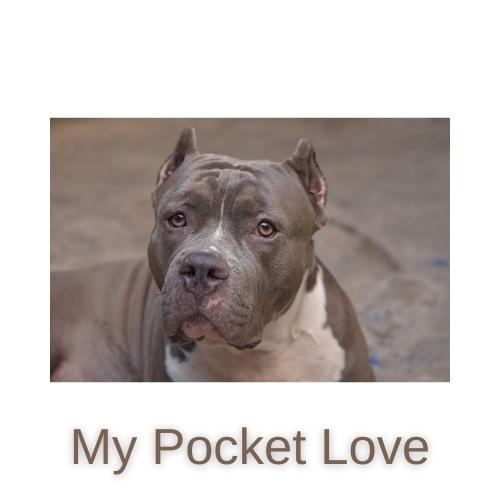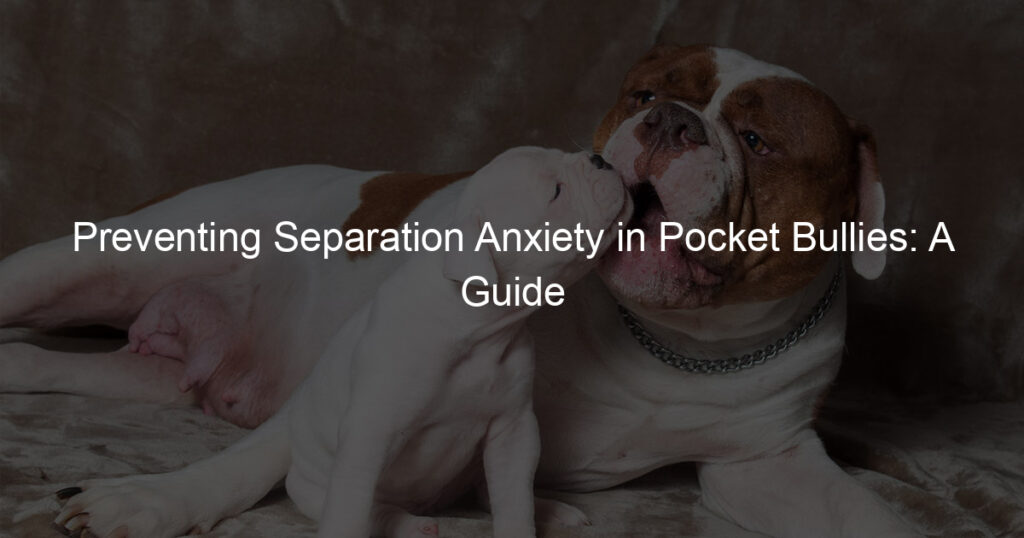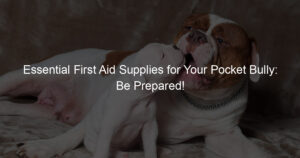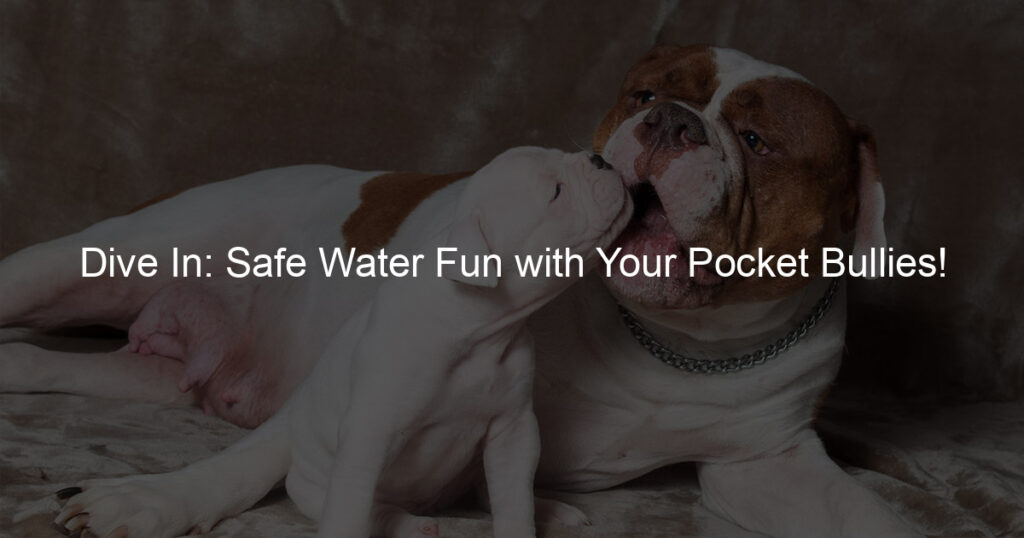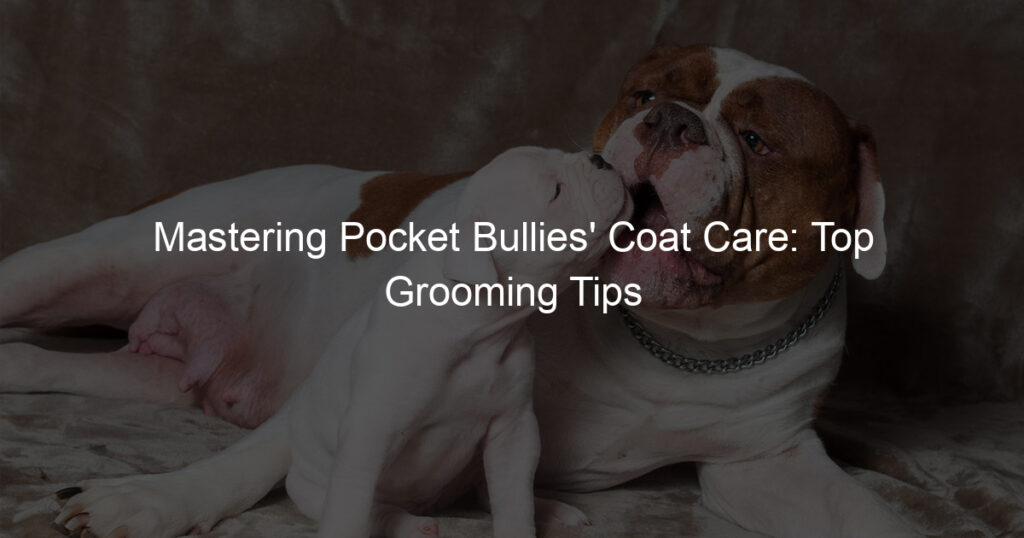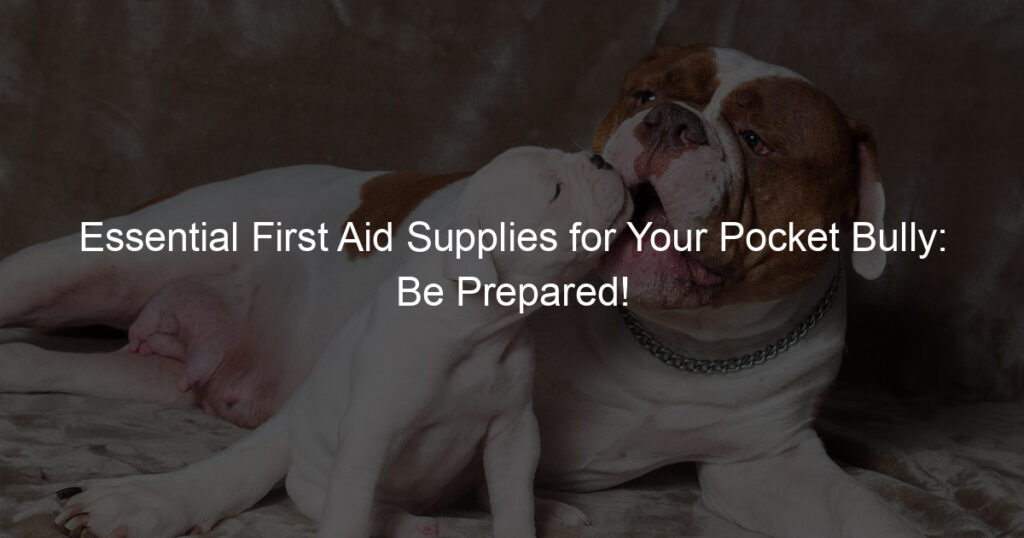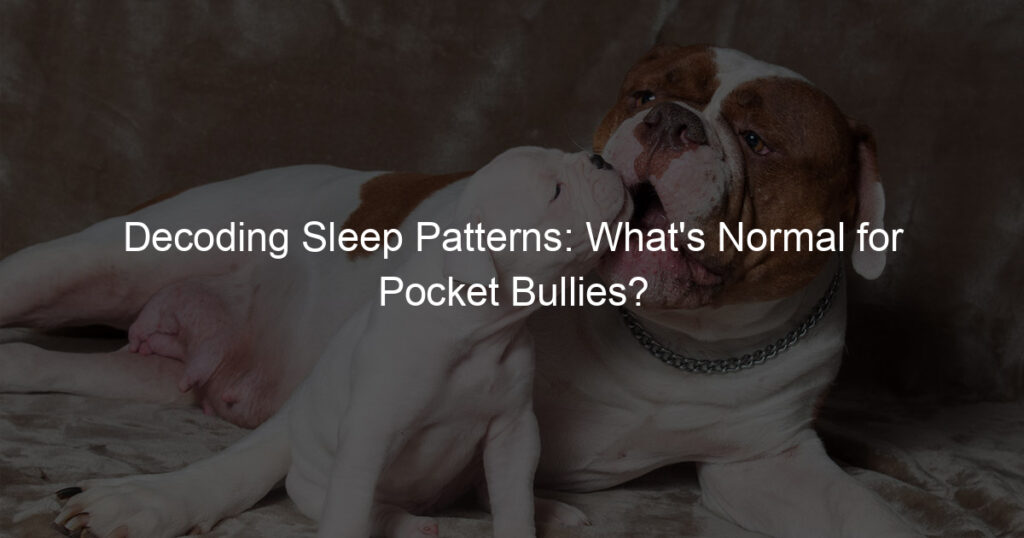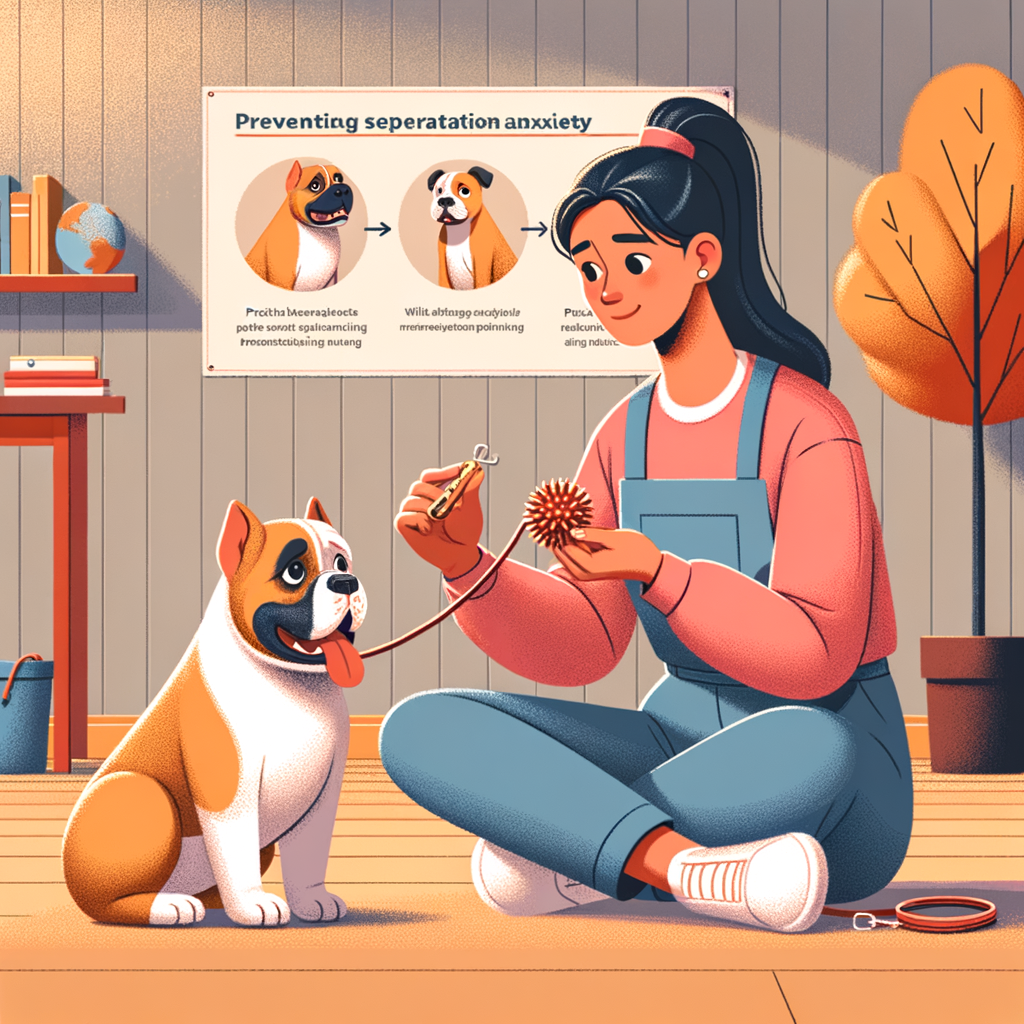
Introduction to Preventing Separation Anxiety in Pocket Bullies
Separation anxiety in Pocket Bullies is a serious concern that pet owners must address. It can lead to various behavioral issues and affect the overall health of your pet. This article aims to provide you with a comprehensive understanding of this issue and how to prevent it.
- Understanding the importance of addressing anxiety in Pocket Bullies
- Common signs of separation anxiety in Pocket Bullies
Separation anxiety in Pocket Bullies is not just about your pet missing you when you’re not around. It’s a serious condition that can lead to destructive behavior, excessive barking, and even health problems like loss of appetite and depression. As a responsible pet owner, it’s crucial to understand the importance of addressing this issue promptly. Not only will it improve your pet’s quality of life, but it will also strengthen your bond with them.
Recognizing the signs of separation anxiety in Pocket Bullies is the first step towards addressing the problem. These signs can vary from one pet to another, but some common ones include excessive barking or howling when left alone, destructive behavior like chewing on furniture or shoes, pacing in a fixed pattern or circle, and attempts to escape from where they’ve been confined. If you notice any of these signs in your Pocket Bully, it’s important to take action immediately.
In the following sections, we will delve deeper into the basics of anxiety prevention, advanced techniques for handling anxiety, long-term strategies for separation anxiety solutions, and a summary of tips to prevent separation anxiety in Pocket Bullies. Stay tuned to learn more about how to ensure your Pocket Bully leads a happy and anxiety-free life.
Pocket Bullies Anxiety Prevention: The Basics
Understanding how to prevent anxiety in Pocket Bullies is essential for any owner. One of the primary ways to achieve this is by creating a safe environment for your pet. Let’s delve into the basics of this approach.
Creating a Safe Environment
Creating a safe and comfortable environment for your Pocket Bully can significantly reduce their anxiety levels. This involves two key steps:
- Importance of a safe space for your Pocket Bully
- How to create a comfortable environment
Just like humans, Pocket Bullies need a space where they feel secure and relaxed. This safe space can be a specific room, a corner of your living room, or even a crate. When your pet feels anxious, they can retreat to this space and calm down. According to a study, dogs that have a designated safe space show fewer signs of anxiety.
Creating a comfortable environment for your Pocket Bully involves several factors. Firstly, ensure the space is quiet and free from loud noises that may startle your pet. Secondly, include comfortable bedding and toys that your pet loves. Finally, maintain a consistent temperature in the space. Too hot or too cold environments can cause discomfort and increase anxiety levels in your Pocket Bully.
Remember, a safe and comfortable environment is just the first step in preventing anxiety in Pocket Bullies. Consistency and routine also play a crucial role, which we will discuss in the next section.
Establishing a Routine
Establishing a consistent routine for your Pocket Bully is not just about training, but it’s also about creating a comfortable and predictable environment for them. This can significantly help in preventing anxiety.
- Benefits of a Consistent Routine
- Examples of Effective Routines for Pocket Bullies
- Morning Walks: Start the day with a morning walk. This can help your Pocket Bully burn off energy and start the day on a positive note.
- Feeding Times: Have set feeding times. This can help regulate your dog’s digestive system and also gives them something to look forward to.
- Training Sessions: Include regular training sessions in your routine. This not only helps with behavior but also provides mental stimulation for your Pocket Bully.
- Play Time: Don’t forget to include play time in your routine. This can help your Pocket Bully bond with you and also provides a fun way for them to burn off energy.
- Bed Time: Have a set bed time. This can help your Pocket Bully wind down and get ready for sleep.
Having a consistent routine can provide numerous benefits for your Pocket Bully. For starters, it can help them understand what to expect, which can significantly reduce anxiety. A routine can also help your pet feel more secure and comfortable in their environment.
According to a study, dogs with a consistent daily routine are less likely to exhibit behavioral problems, including separation anxiety. This is because routines provide structure, and structure can help dogs feel safe.
Creating an effective routine for your Pocket Bully doesn’t have to be complicated. Here are a few examples:
Remember, the key to a successful routine is consistency. Try to stick to the same schedule as much as possible. This can help your Pocket Bully feel more secure and can significantly reduce anxiety.
Handling Anxiety in Pocket Bullies: Advanced Techniques
When it comes to managing anxiety in Pocket Bullies, it’s important to understand that there are advanced techniques that can help. These techniques go beyond the basics and provide a more comprehensive approach to anxiety management.
Training Methods
Training is a powerful tool that can help manage and reduce anxiety in Pocket Bullies. Let’s explore some effective training techniques and a case study that demonstrates their success.
- Effective training techniques for anxiety management
- Case study: Successful use of training to reduce anxiety
One of the most effective training techniques for managing anxiety in Pocket Bullies is desensitization. This involves gradually exposing your dog to the source of their anxiety in a controlled way, allowing them to become accustomed to it over time. Another technique is counter-conditioning, which involves changing your dog’s emotional response to the anxiety-inducing stimulus. For example, if your dog becomes anxious when left alone, you might start by leaving for short periods and gradually increase the time, rewarding your dog for calm behavior each time you return.
Consider the case of Max, a two-year-old Pocket Bully who suffered from severe separation anxiety. Max’s owners implemented a combination of desensitization and counter-conditioning techniques. They started by leaving Max alone for just a few minutes at a time, gradually increasing the duration. They also used positive reinforcement, rewarding Max for calm behavior. Over time, Max’s anxiety levels decreased significantly. This case study demonstrates that with patience and consistent training, it’s possible to manage and reduce anxiety in Pocket Bullies.
In conclusion, training methods can play a crucial role in managing anxiety in Pocket Bullies. By using techniques such as desensitization and counter-conditioning, and by rewarding calm behavior, it’s possible to reduce anxiety levels and improve your dog’s quality of life.
Professional Help
There are times when managing your Pocket Bully’s anxiety may require the assistance of a professional. This section will guide you on when to seek professional help and how they can assist in managing your Pocket Bully’s anxiety.
- When to Seek Professional Help
- Continued destructive behavior even after implementing anxiety prevention techniques.
- Excessive barking or howling when left alone.
- Exhibiting signs of distress such as excessive panting, drooling, or attempts to escape.
- How Professionals Can Assist in Managing Your Pocket Bully’s Anxiety
- Diagnosis: Professionals can accurately diagnose your Pocket Bully’s anxiety, determining whether it’s separation anxiety or another type of anxiety.
- Treatment plan: Based on the diagnosis, professionals can create a personalized treatment plan. This plan may include behavior modification techniques, environmental changes, and in some cases, medication.
- Follow-up: Regular follow-ups with the professional can ensure your Pocket Bully’s treatment plan is working and can be adjusted as needed.
Recognizing when to seek professional help is crucial for your Pocket Bully’s wellbeing. If your dog’s anxiety symptoms persist despite your best efforts, it may be time to consult a professional. Signs that your Pocket Bully may need professional help include:
Remember, it’s always better to seek help sooner rather than later. Early intervention can prevent your Pocket Bully’s anxiety from escalating.
Professionals such as veterinarians and certified dog behaviorists have the knowledge and experience to diagnose and treat anxiety in dogs. Here’s how they can help:
Remember, seeking professional help is not a sign of failure. It’s about doing what’s best for your Pocket Bully.
Pocket Bullies Separation Anxiety Solutions: Long-Term Strategies
When it comes to managing separation anxiety in Pocket Bullies, long-term strategies often involve making changes to your lifestyle. These changes can help your furry friend feel more secure and less anxious when you’re not around.
Adapting Your Lifestyle
Adapting your lifestyle doesn’t mean you have to make drastic changes. Small, consistent modifications can make a big difference in your Pocket Bully’s anxiety levels. Let’s explore some of these changes.
- Changes you can make to your lifestyle to help your Pocket Bully
- Key takeaways: Lifestyle adaptations for long-term anxiety management
Firstly, try to establish a predictable routine. Pocket Bullies thrive on consistency. Regular feeding, play, and exercise times can help reduce anxiety. Secondly, consider using calming aids like anxiety wraps or calming music when you’re away. Lastly, practice leaving and returning home without making a fuss. This can help your pet understand that your departures and arrivals are normal, not something to fear.
In summary, managing your Pocket Bully’s separation anxiety involves establishing a consistent routine, using calming aids, and normalizing your departures and arrivals. Remember, these changes may take time to show results, but consistency is key. Your patience and dedication can help your Pocket Bully lead a happier and less anxious life.
By adapting your lifestyle to better suit your Pocket Bully’s needs, you can effectively manage their separation anxiety in the long term. Remember, every dog is unique, so it may take some time and experimentation to find what works best for your pet.
Medical Treatments
When it comes to managing separation anxiety in Pocket Bullies, medical treatments can play a significant role. Let’s dive into an overview of these treatments and explore a case study that demonstrates the successful use of medication.
- Overview of Medical Treatments for Separation Anxiety
- Case Study: Successful Use of Medication in Treating Separation Anxiety
Medical treatments for separation anxiety in Pocket Bullies typically involve the use of medications that help to calm the dog and reduce their anxiety levels. These medications can include anti-anxiety drugs, antidepressants, and in some cases, sedatives. It’s important to note that these treatments should always be used under the supervision of a qualified vet and in conjunction with behavioral therapy.
| Medication | Use |
|---|---|
| Anti-anxiety drugs | Helps to calm the dog and reduce anxiety levels |
| Antidepressants | Helps to manage mood and reduce symptoms of anxiety |
| Sedatives | Used in severe cases to help the dog relax |
Let’s take a look at a case study that demonstrates the successful use of medication in treating separation anxiety in Pocket Bullies. A 3-year-old Pocket Bully named Max was suffering from severe separation anxiety. His owners tried various behavioral therapies, but Max’s anxiety levels remained high. After consulting with their vet, they decided to try medication.
Max was prescribed a low dose of an anti-anxiety medication. Alongside this, his owners continued with the behavioral therapy. After a few weeks, they noticed a significant improvement in Max’s behavior. He was less anxious when left alone and showed fewer signs of distress. This case study highlights the potential benefits of combining medication with behavioral therapy in managing separation anxiety in Pocket Bullies.
Tips to Prevent Separation Anxiety in Pocket Bullies: A Summary
As we wrap up our discussion on separation anxiety in Pocket Bullies, let’s take a moment to recap the most effective strategies we’ve covered and share some final thoughts on managing and reducing anxiety in these adorable pets.
- Recap of the most effective strategies for preventing separation anxiety
Firstly, we discussed the importance of establishing a routine for your Pocket Bully. This helps them understand when you’ll be away and when you’ll return, reducing their anxiety. We also highlighted the value of gradual desensitization, where you slowly increase the time you spend away from your pet, helping them get used to your absence.
Another effective strategy we covered was the use of distraction techniques, such as toys or treats, to keep your Pocket Bully occupied while you’re away. We also emphasized the role of exercise in reducing anxiety, as a tired dog is a happy dog.
Lastly, we touched upon the benefits of professional help in severe cases of separation anxiety. This could include a dog trainer, a behaviorist, or even medication in some instances.
- Final thoughts on managing and reducing anxiety in Pocket Bullies
Managing and reducing anxiety in Pocket Bullies is a journey, not a destination. It requires patience, consistency, and understanding. Remember, your pet is not acting out of spite or malice – they’re simply expressing their fear and distress in the only way they know how.
With the right approach and the strategies we’ve discussed, you can help your Pocket Bully feel more secure and less anxious when you’re not around. And remember, every dog is unique – what works for one might not work for another. So, don’t be afraid to try different strategies and see what works best for your pet.
In conclusion, separation anxiety in Pocket Bullies is a manageable condition. With love, patience, and the right strategies, you can help your pet live a happy, anxiety-free life.
